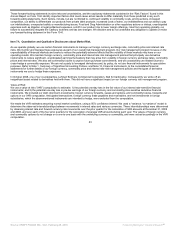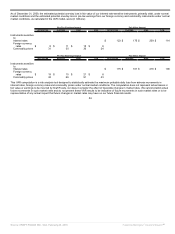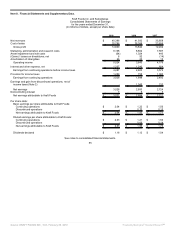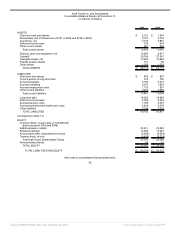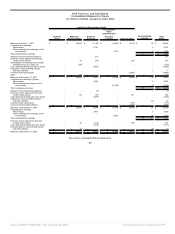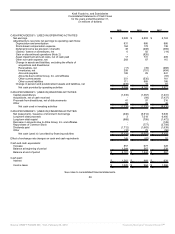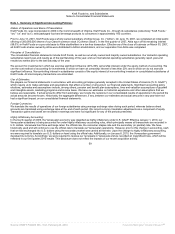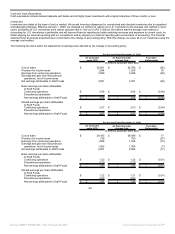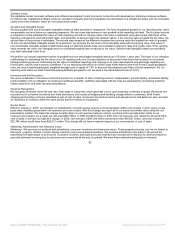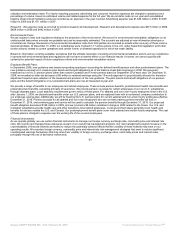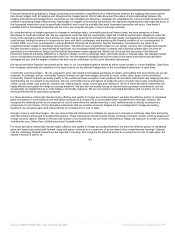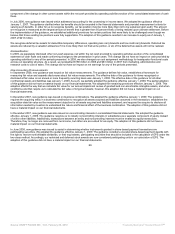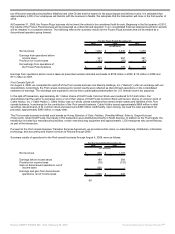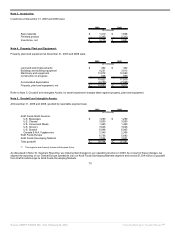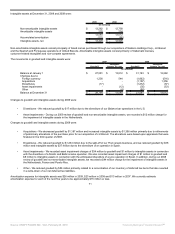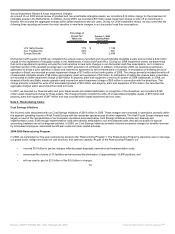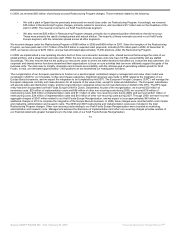Kraft 2009 Annual Report Download - page 66
Download and view the complete annual report
Please find page 66 of the 2009 Kraft annual report below. You can navigate through the pages in the report by either clicking on the pages listed below, or by using the keyword search tool below to find specific information within the annual report.
utilization and redemption rates. For interim reporting purposes, advertising and consumer incentive expenses are charged to operations as a
percentage of volume, based on estimated volume and related expense for the full year. We do not defer costs on our year-end consolidated
balance sheet and all marketing costs are recorded as an expense in the year incurred. Advertising expense was $1,648 million in 2009, $1,639
million in 2008 and $1,471 million in 2007.
Research - We expense costs as incurred for product research and development. Research and development expense was $477 million in 2009,
$498 million in 2008 and $442 million in 2007.
Environmental Costs:
We are subject to laws and regulations relating to the protection of the environment. We accrue for environmental remediation obligations on an
undiscounted basis when amounts are probable and can be reasonably estimated. The accruals are adjusted as new information develops or
circumstances change. Recoveries of environmental remediation costs from third parties are recorded as assets when recovery of those costs is
deemed probable. At December 31, 2009, our subsidiaries were involved in 71 active actions in the U.S. under Superfund legislation (and other
similar actions) related to current operations and certain former or divested operations for which we retain liability.
Based on information currently available, we believe that the ultimate resolution of existing environmental remediation actions and our compliance
in general with environmental laws and regulations will not have a material effect on our financial results. However, we cannot quantify with
certainty the potential impact of future compliance efforts and environmental remediation actions.
Employee Benefit Plans:
In September 2006, new guidance was issued surrounding employers’ accounting for defined benefit pension and other postretirement plans. The
new guidance required us to measure plan assets and benefit obligations as of the balance sheet date beginning in 2008. We previously
measured our non-U.S. pension plans (other than certain Canadian and French pension plans) at September 30 of each year. On December 31,
2008, we recorded an after-tax decrease of $8 million to retained earnings using the 15-month approach to proportionally allocate the transition
adjustment required upon adoption of the measurement provision of the new guidance. The plan assets and benefit obligations of our pension
plans and the benefit obligations of our postretirement plans are now all measured at year-end.
We provide a range of benefits to our employees and retired employees. These include pension benefits, postretirement health care benefits and
postemployment benefits, consisting primarily of severance. We provide pension coverage for certain employees of our non-U.S. subsidiaries
through separate plans. Local statutory requirements govern many of these plans. For salaried and non-union hourly employees hired in the U.S.
after January 1, 2009, we discontinued benefits under our U.S. pension plans, and we replaced them with an enhanced company contribution to
our employee savings plan. Additionally, we will be freezing the U.S. pension plans for current salaried and non-union hourly employees effective
December 31, 2019. Pension accruals for all salaried and non-union employees who are currently earning pension benefits will end on
December 31, 2019, and continuing pay and service will be used to calculate the pension benefits through December 31, 2019. Our projected
benefit obligation decreased $168 million in 2009, and we incurred a $5 million curtailment charge in 2009 related to the freeze. Our U.S. and
Canadian subsidiaries provide health care and other benefits to most retired employees. Local government plans generally cover health care
benefits for retirees outside the U.S. and Canada. Our postemployment benefit plans cover most salaried and certain hourly employees. The cost
of these plans is charged to expense over the working life of the covered employees.
Financial Instruments:
As we operate globally, we use certain financial instruments to manage our foreign currency exchange rate, commodity price and interest rate
risks. We monitor and manage these exposures as part of our overall risk management program. Our risk management program focuses on the
unpredictability of financial markets and seeks to reduce the potentially adverse effects that the volatility of these markets may have on our
operating results. We maintain foreign currency, commodity price and interest rate risk management strategies that seek to reduce significant,
unanticipated earnings fluctuations that may arise from volatility in foreign currency exchange rates, commodity prices and interest rates,
principally through the use of derivative instruments.
63
Source: KRAFT FOODS INC, 10-K, February 25, 2010 Powered by Morningstar® Document Research℠


